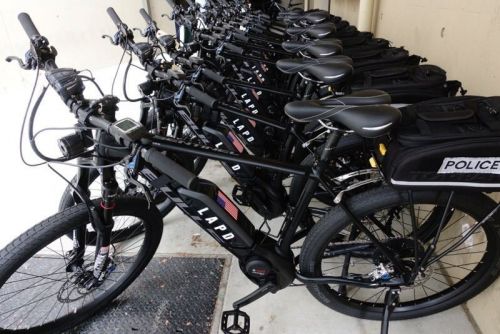YUCAIPA, Calif. (BRAIN) — While the number of agencies using e-bikes is unknown, a police bicycle safety group said their adoption is "growing rapidly," further fueling the e-bike market. That's leading to opportunities for suppliers and retailers, and the need for patrollers to update their training as more officers navigate bikes with top speeds of 28 mph and weighing an average of 50 pounds.
With more than 12,000 police and 3,000 sheriff's departments nationwide, the Bureau of Justice Statistics currently only tracks the number of bike patrols, not which type of bike or how many are used. Maureen Becker, the International Police Mountain Bike Association's executive director, estimated about 4,000 police departments, sheriff's offices and campus law enforcement agencies use bikes in some capacity. Some park and forest rangers also use bikes and e-bikes.
While hard numbers are hard to find "it appears that e-bikes are gaining in popularity based on the volume of news stories about agencies either buying or accepting donations of e-bikes as well as inquiries from our members and instructors regarding such topics as equipment selection, training and operations," Becker said.
Chief among those agencies going electric is the Los Angeles Police Department, the third largest force in the U.S. It began converting its 500-bike fleet to e-bikes last year. With the LAPD's input, Bulls Bikes created the Bosch-powered Sentinel police e-bike model.
"We were confident that we could deliver, and we had a comparable if not superior bike to our competitors," said Adam Anderson, assistant manager of sales and marketing at Bulls Bikes. "It's good for the market and good for our business."
Headlined by the Sentinel, the Bulls e-bikes making up the LAPD's fleet would sell for $4,099-$5,299. Anderson declined to say how much the LAPD paid because "this is a special case because of their closeness to the project." Bulls e-bikes are available only through specialty bike stores.
Anderson said several additional police forces, including those from the District of Columbia and Las Vegas, have shown interest. Other brands with police e-bike models include Trek, Raleigh, Pedego, IZIP and Detroit Bikes.
As for repairs and maintenance, agencies usually establish a contract with their dealer. It includes repairs and semi-annual to quarterly adjustments, Anderson said.
Becker said retailers shouldn't necessarily count on large group sales if interest continues.
"More than half of the police departments in the United States have fewer than 10 officers, so they are far more likely to sell one or two bikes at a time, not dozens or hundreds," she said. "Their focus should be building on long-term relationships. Some manufacturers seem to view selling to police departments as a get-rich-quick scheme, but that is not the case."
While it might be true you never forget how to ride a bike, navigating an e-bike efficiently and safely comes with some risks for officers.
That means not only getting officers up to speed quickly, but getting them to and from the scene safely. National certification is not required, and training is left to each agency. Clint Sandusky, a retired Los Angeles County Sheriff's Deputy who organizes e-bike workshops for IPMBA, said training is "essential."
IPMBA recommends personnel complete a police cyclist course on a pedal bike before additional e-bike training. Sandusky, a California POST-certified bike patrol instructor since 1994, said officers need to be able to master slow-speed handling and obstacle clearing.
E-bikes allow officers to respond faster with less fatigue, expand their range and enhance community engagement. Their stealthy nature is what attracted the City of Bend (Oregon) Police Department to purchase four e-bikes recently. Sterling McCord, owner of Bend Electric Bikes, sold two Sentinels to the force, in addition to several accessories.
"(Officers) say, 'I'm driving around the corner and a guy is stealing a car stereo and hears me roll up in my police cruiser before I'm even on the scene,'" McCord said "'And he goes and hides behind a tree, and I drive right by him. Then he goes back to stealing radios.'
"They're excited about that stealth component (to e-bikes)."
So much so that McCord upgraded his officers' bikes to quieter freehubs.
LAPD Sgt. Shannon Geaney was one of two officers assigned on e-bikes during the Hollywood Division's New Year's Eve deployment in 2018. She credits it for getting her to the scene of an active shooting quicker because she could avoid the gridlock of the festivities.
Acceptance of e-bikes was slow in coming, according to Michael Espejo, owner of Police Bike Store, which sells bikes and accessories online. He blames a lack of training and early reliance on rear hub motors.
"With the advent of the mid-motor systems, utilizing regular rear wheels that are easily swapped out if need be and feel much better when riding, the police began to adopt e-bikes and see the benefits of them during patrol," he said. "The pedal-assist technology has also greatly assisted with this."
Espejo said because of higher initial cost, many agencies need training and education before investing, making it critical for retailers to have demo units.
Ben Serotta, who consults with e-bike sharing companies and owns The Serotta Design Studio, pumped the brakes on the outlook of the police e-bike market.
"In general, police departments globally are seeing small, light, quiet and cheaper transportation alternatives to cruisers as a smarter alternative in many congested-area applications," Serotta said. "There are still forces that don't fully understand all the advantages. ... So enlightenment comes at a different pace in different locations."
A version of this story appeared in the August 1 issue of BRAIN.


